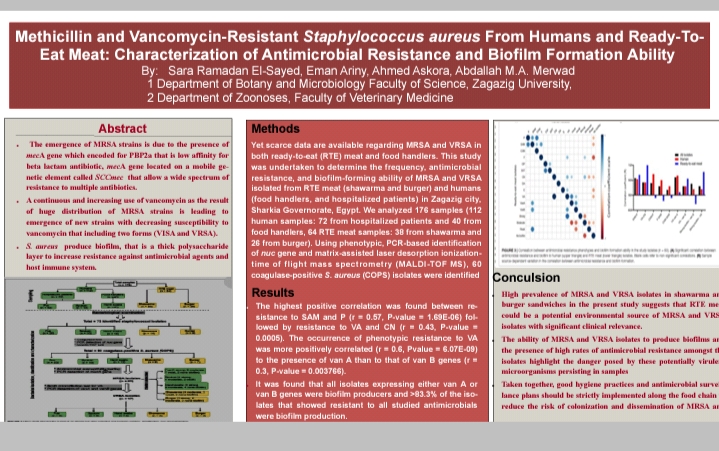Sara Ramadan El-Sayed Moselhy
Conference 2023 Presentation
Project title
MRSA and VRSA From human and ready-to-eat meat products: CharacterizationofAntimicrobial ResistanceandBiofilmFormation Ability of
Authors and Affiliations
TaisirSaber1‡,MohamedSamir2*†,RashaM.El-Mekkawy3,EmanAriny3, SaraRamadanEl-Sayed3,GamalEnan Q3 3,SawasnH.Abdelatif4,AhmedAskora3, AbdallahM.A.Merwad2andYasmineH.Tartor5*†
1.DepartmentofMedicalMicrobiologyandImmunology,FacultyofMedicine,ZagazigUniversity,Zagazig,Egypt,
2.DepartmentofZoonoses,FacultyofVeterinaryMedicine,ZagazigUniversity,Zagazig,Egypt,
3.DepartmentofBotanyandMicrobiology,FacultyofScience,ZagazigUniversity,Zagazig,Egypt,
4.DepartmentofPediatrics,ZagazigUniversity, Zagazig,Egypt,
5.DepartmentofMicrobiology,FacultyofVeterinaryMedicine,ZagazigUniversity,Zagazig,Egypt
Abstract
Background
Methicillin-resistant and vancomycin-resistant Staphylococcus aureus (MRSAand VRSA) are zoonoticlife-threatening pathogens, and their presence in food raises a public health concern.Yet, scare data are available regarding MRSA and VRSA in both ready-to-eat (RTE) meatandfoodhandlers.Thisstudywasundertaken to determine the frequency, antimicrobial resistance, andbiofilm-forming ability of MRSA and VRSA isolated from RTE meat (shawarma and burger)and humans (food-handlers, and hospitalized patients) in Zagazig city, Sharkia Governorate, Egypt.
Methods
We analyzed 176 samples (112human samples:72 from hospitalized patients and 40 from food handlers, 64 RTE meat samples: 38 from shawarma and 26 from burger).Using phenotypic,PCR-based identification of nuc gene and matrix assisted laser desorption ionization (MALDI) TOF masss pectrometry, 60 coagulase-positive S.aureus(COPS) isolates were identified in the samples
Results
RTEmeat(15/64,23.4%),hospitalized patients(33/72,45.8%)andfoodhandlers(12/40,30%).AlltheCOPSisolateswere mecApositive(andthuswereclassifiedasMRSA)andmultidrugresistantwithmultiple antibioticresistanceindicesrangingfrom0.25to0.92.Overall,resistancetocefepime (96.7%),penicillin(88.3%),werecommon,followedbyampicillin-sulbactam(65%), ciprofloxacin(55%),nitrofurontoin(51.7%),andgentamicin(43.3%).VRSAwasdetected in30.3%ofCOPShospitalizedpatient’sisolates,26.7%ofCOPSRTEmeatisolates and25%ofCOPSfoodhandler’sisolates.VanA,vanB,orbothgenesweredetected in64.7,5.9,and29.4%ofallVAN-resistantisolates,respectively.Themajorityofthe COPSisolates(50/60,83.3%)havebiofilmformationabilityandharboredicaA(76%), icaD(74%),icaC(50%),andicaB(46%)biofilm-forminggenes.Thebapgenewasnot detectedinanyoftheisolates
Conclusions
biofilmsinadditiontobeingresistanttoantimicrobialshighlightthedangerposedby these potentially virulent microorganisms persisting in RTE meat, foodhandlers, and patients.Taken together, good hygiene practices and antimicrobial surveillance plans should be strictly implemented along the food chain to reduce the risk of colonization and dissemination of MRSA and VRSA biofilm-producing strains.

